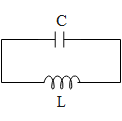Question
Question: A capacitor in an ideal LC circuit is fully charged by a DC source, then it is disconnected from the...
A capacitor in an ideal LC circuit is fully charged by a DC source, then it is disconnected from the DC source, the current in the circuit is
a) becomes zero instantaneously
b) grows monotonically
c) decays monotonically
d) oscillate infinitely
Solution
It is given that the capacitor and the inductor are connected across a Dc source and once the capacitor gets fully charged the DC source is removed from the circuit. When the capacitor and the inductor are joined together, the potential difference across the capacitor(VC) will be equal to the potential difference across the inductor (VL). Hence we will use the expression of the voltage across the inductor and the capacitor and obtain an expression for current. From this expression we will determine the correct option from the ones provided.
Formula used:
VL=Ldtdi
VC=Q/C
Complete answer:

In that above diagram we can see that the inductor L and capacitor C are connected to each other. Hence the potential difference across each of them will be the same.
The potential difference across the inductor (L) is given by,VL=Ldtdi where dtdiis the rate of change of current in the circuit. Similarly the voltage across the capacitor (C) is given by the VC=Q/C, where Q is the charge stored on the capacitor. Since VL=VC, we can write,
Ldtdi=CQ
Differentiating the above equation we get,
Ldtd(dtdi)=CdtdQ, sincedtdQ=i⇒Ldt2d2i=Ci⇒Ldt2d2i+Ci=0
The solution of the above second order differential equation is,
i=i∘Sin(ωt+ϕ) where i is the instantaneous current in the circuit,i∘ is the maximum current in the circuit over a complete cycle, ω=LC1 is the angular frequency of the current in the circuit, and ϕ is the phase constant. The current in the circuit is equal to the Sine function. Hence we can conclude that the current in the circuit will be oscillatory. Let us say there is no loss of energy from the inductor nor the capacitor. Hence the current in the circuit will keep on oscillating till infinity.
So, the correct answer is “Option D”.
Note:
The capacitor in the circuit is initially charged and hence it will discharge along the inductor. Hence the capacitor is discharging the current keeps on changing. Therefore when the capacitor is fully discharged the inductor will produce a back emf thereby delivering current to the capacitor. As a result the capacitor will again get charged. This process of charging and discharging keeps on continuing till an infinite amount of time provided there is no loss of energy.
